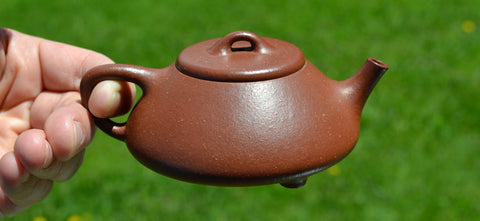Jiangponi: New Kid on the Block
Unlike clays such as zini or hongni, the use of jiangponi for teapots does not have a long history stretching back hundreds of years. In fact, jiangponi is a very young addition to the family of clays used for Yixing teapots, only having been discovered several decades ago.

Jiangponi Teapot
The clay was discovered in the 1990s while building a road between Huanglong Mountain 黄龙山 and Qinglong Mountain 青龙山 in Yixing. While digging to lower the slope of the road, workers discovered a layer of zisha ore (Yixing Clay). The discovery of zisha was nothing extraordinary, since zisha deposits are often discovered when doing construction in Yixing (a lot of the clay mined for teapots is discovered this way), however the unique appearance of the ore attracted attention. The colourful ore was found to be a naturally-occurring mixture of three kinds of zisha: Hongni (red clay), Zini (purple clay), and Duanni (yellow clay).
The story has it that a few potters decided to process the ore into clay to see what the quality was like. After processing it, shaping it and firing it, they found the clay was very well suited for tea. The clay was named “jiangponi” 降坡泥 or “lower slope clay” after the site of its discovery.

Jiangponi ore
The Rainbow Clay
Jiangponi appears in a range of colors from yellow-brown to red-brown-purple. The color of the jiangponi depends on the percentage of each kind of clay in the ore. The ore found closer to Huanglong Mountain has a higher percentage of hongni and the finished clay is redder than the clay that comes from ore found further away. This kind of jiangponi is sometimes referred to as “jiangpo hongni” 降坡红泥 and is the preferred type of jiangponi. Jiangponi that is closer to Qinglong mountain has a higher percentage of duanni, is sandier, is harder to fire successfully, and is considered to be of lower quality.
Jiangponi is fired at temperatures slightly higher than hongni, at between 1150-1200C. The shrink rate of the clay during firing is around 12%.
The mixture of hongni and zini is visible in the red-purple/brown color of the teapot. The sandy duanni appears as small flecks on the clay, like stars at night. This is one of the more beautiful and identifiable elements of the clay.

Jiangponi teapot surface with gold flecks of duanni visible.
Brewing Tea with Jiangponi
From our own experience we find it is very suitable for puer, black tea, and heavily-roasted oolongs such as yancha. It is very good for muting some of the astringency, smoke and other unpleasant flavours. We have also found jiangponi to be a very easy clay to season and one of the fastest to show results. After only about a month of regular use the clay will develop a nice subtle shine.

Jiangponi teapot after a few months of use.
